Plesk WP Toolkit Quick & Comprehensive Guide
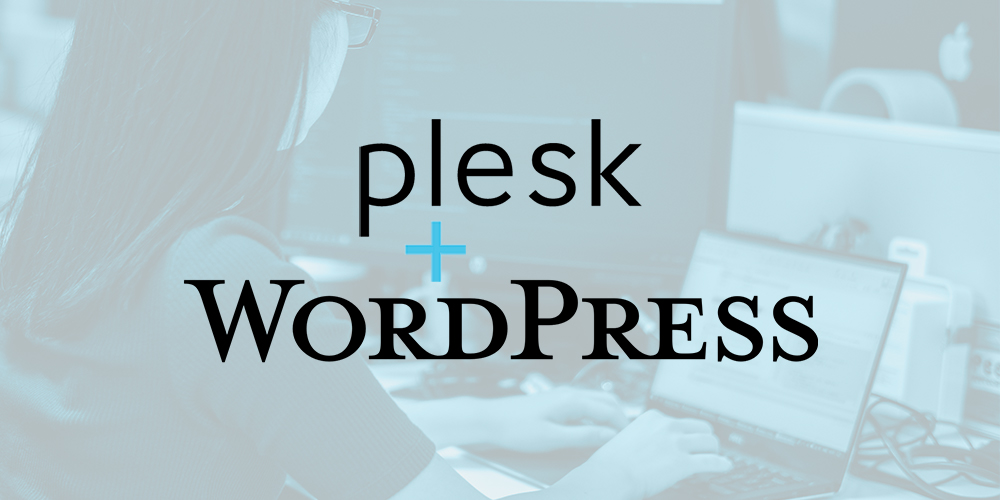
WordPress is amazingly incredible, and it brings several benefits that you might not expect from a content management system (CMS). It is very easy to manage everything on WordPress, from a new blog to news publishing. This is why it’s so popular across many different channels. Plus there are added features for any niche thanks to easy-to-use plugins and tools.
When it comes to running WordPress on your website you are left with a few options. Managed hosting companies like WP Engine make things easy and install WordPress for you. But for those using shared hosting you often have the choice of cPanel, Ubuntu or Plesk.
Plesk is a web hosting control panel that can be installed on both Linux and Windows servers. If you use Media Temple VPS you might have seen it before. But you can also install it yourself and use it to manage WordPress installs more easily on your own server.
Plesk 17 WP Toolkit is an extension for Plesk to add a range of WordPress functionality. It is a useful (and easy) option to manage your WordPress themes, plugins, security, updates, and more in an easy way.
WP Toolkit in Plesk
Plesk is a complete, versatile and secure toolkit for WordPress that provides a single dashboard to manage multiple WordPress instances easily. With Plesk it’s super-easy to test new plugins, features and design ideas in a sandbox before you publish them on your live website. For this you’ll not required any extra plugins or separate server – the Plesk WP Toolkit manages it all.
You can also use the Plesk WP Toolkit to eliminate some of the complexity of managing WordPress websites. Staging, cloning, syncing, updating, migrating and other complex tasks – it is easy to get it done with just one simple click.

The Plesk WP Toolkit provides a single management interface to easily install (one-click installer), configure and manage WordPress. You need to install the WP Toolkit extension in Plesk and you can start work with it.
WP Toolkit does require Plesk (of course) as well as a server PHP version 5.3 or higher version. If your server is still using a PHP version below this then you will need to add a custom PHP handler. To enable this, you will need to specify the path to the PHP binary and switch the subscription with WP Toolkit to the custom PHP handler.
Moreover, Plesk WP Toolkit is free for the owners of Plesk Web Host and Plesk Web Pro editions. Plesk Web Admin users are offered a different SE version with less features.
Now let’s look at how you can use the WP Toolkit in Plesk.
WordPress Installation with Plesk
First you need to log into your Plesk panel. From here you should have the following installation options available:
- Websites & Domains > WordPress > Install
- Applications > WordPress > Install
- Subscription > WordPress > Install
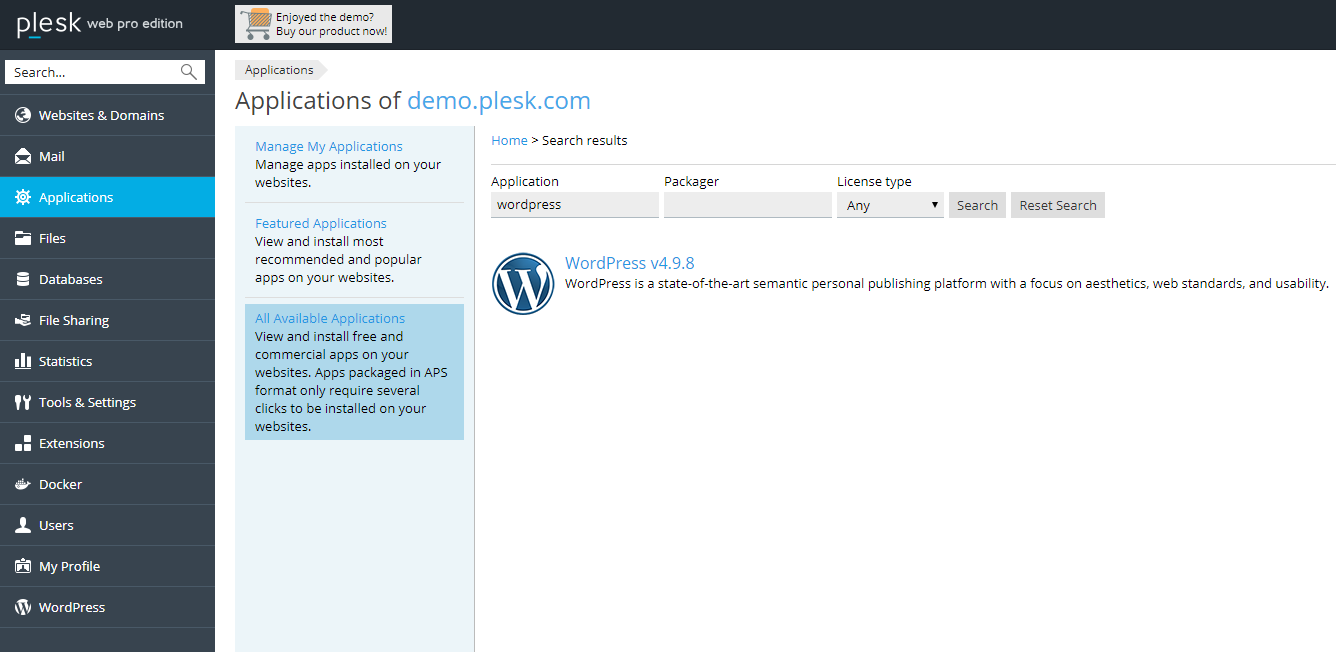
Click on the Websites & Domains tab and you should see a WordPress icon on the upper right side of your Plesk dashboard. Click on the WordPress icon and click on Install button to install a WordPress in your Plesk panel.
Manage WordPress Installations
After successful installing WordPress with Plesk (or importing a site via Websites & Domains > WordPress > Import), your next step is to go to the Plesk WP Toolkit dashboard to get a broad look at the WordPress websites running on your server. From this main page you can view all of your installations at a glance.
You can easily switch between cards, lists, or tiles as per your visual preference.
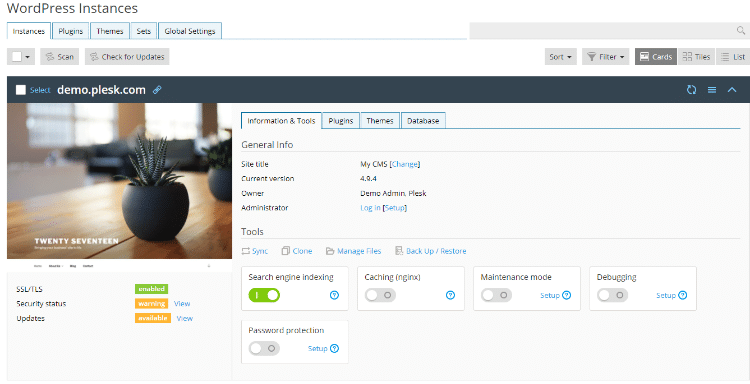
From the Information & Tools card tab you’ll have access to controls and tools for your site. Use the toggles to quickly disable search engine indexing, enable maintenance mode and debugging, turn on caching or restrict public access by turning on password protection.
You’ll also find quick links to sync, clone, manage files, and backup/restore your files.
Hint: Use the Clone button to spin up a staging site for your testing purpose quickly.
Manage WordPress Plugins
With the Plesk WP Toolkit plugin management is also made easy. You can install, activate and remove plugins all from your dashboard.

Install Plugins
there are two options for installing plugins. Add a plugin to a specific site, go to: WordPress > the Plugins tab for a site > Install
Or if you’d like to install a new plugin on all of your WordPress sites then navigate to the more general: WordPress > Plugins > Install
In either case, click on the search icon and search for a plugin. By default, when you install a plugin using the WP Toolkit it’s automatically activated.
You can also upload a third party plugin (such as one you’ve purchased on CodeCanyon, or a new extension from WooCommerce). Simply go to: WordPress > Plugins > Upload Plugin
Then select your plugin zip file and click Upload. To install and activate the plugin, go to: WordPress > Plugins
Click to install your new plugin, then select the WordPress sites you’d like to add it to.
Remove Plugins
However, you can select any plugins to remove from your WordPress by selecting and clicking on delete icon to remove it from selected installation.
Now, choose the WordPress installation you want to activate and deactivate any installed plugin.
Go to the Server Management > WordPress > Plugins tab and select the plugin you want to activate or deactivate.
Manage WordPress Themes
Using Plesk, it is very easy to add, remove, activate or deactivate any WordPress theme.

Install Themes
Go to WordPress > Themes tab > Install to add a new theme. Use the search to find a theme, and tick the checkbox for the theme you want to add.
Just like with plugins, you can add the same theme for all WP instances or add a specific theme to just one specific instance (or more). To do so you need to click on the drop down and then select the instances you want to add or remove a theme.
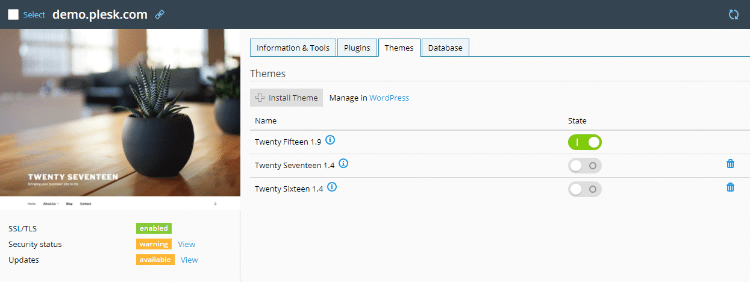
Moreover, you can also easily update any theme from the WordPress > Themes tab. Simply select the theme you want to update for your installations (though we always recommend updating for security – if you’re using a WordPress child theme for customizations you shouldn’t have to worry).
WordPress Security
You can perform a security check for your website with Plesk’s WP Toolkit. You’ll be able to see if all/readme.html/files are empty. You can also easily change your security settings and view your security status. For that you need to go to the S column in the section Websites & Domain > WordPress.

Click on the “check security” link to see the status for all of your WordPress installations. Select the checkboxes with the security improvement you want to perform and then click on the secure button.

That’s how you can drastically reduce the chances of someone breaking into your site by ensuring WordPress website security of the highest level.
Backup & Restore
Along with general WordPress site security, WP Toolkit in Plesk can also be used to backup your site.
Plesk Toolkit for WordPress makes it easy to create scheduled backups for your website. Follow the steps to make sure that you have up-to-date data to restore from where you can take backup when needed:
- First log into Plesk dashboard
- Click on Domains
- Then click on Manage Domain or Manage Hosting
- Now click on Websites & Domains
- Click on Backup Manager
- Click on Scheduled Backup Settings

Here you can choose your options in the Backup Settings, which includes adding a prefix to your backup name, select a multivolume backup, backup storage location, and setting a limit to the backup (the number of copies of your backup) on your server. You can even set a notification alert.
If you go to the Schedule section, you can also activate and automate your backup task. Choose a backup frequency for your website yo have regular site backups made for your. Just select the time to start your backup process and save.
Edit Global Settings
Finally, in the Global Setting area you can configure your maintenance page, and the default subdomain prefix for cloning, which will let you change the staging site URL.
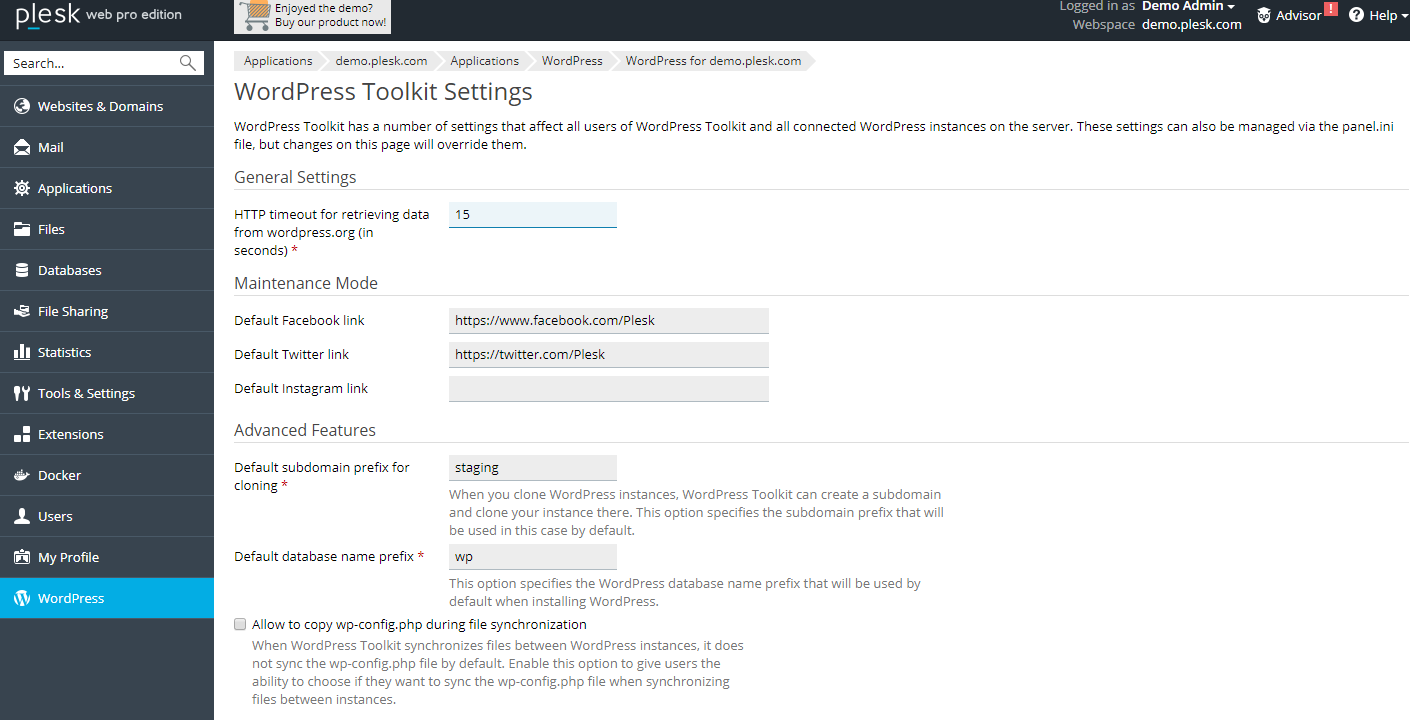
Conclusion
Managing WordPress sites manually can be quite complex. A powerful control panel like Plesk makes it easier, and with the WP Toolkit in Plesk you can manage all your sites from a single dashboard.
If you’re an agency hosting multiple client sites, or an avid writer with a blog in every niche, then the Plesk WP Toolkit is one of your best options to manage all your sites. Work smarter not harder, and manage your WordPress sites effectively without any fuss.
What are your thoughts on the WP Toolkit in Plesk? Or do you have any questions about getting started with it? Leave us a comment below!




It is indeed a very nice tool. I like making sets for plugins. But I find it strange that at a Reseller level you cannot make/edit sets. I think the Reseller is the level where it happens in working for clients……
Peter Luit
The Netherlands
With the Web Host edition (which includes reseller features) full Toolkit features should be available… But definitely take a look at their plan comparison page or reach out to their customer support to be sure.